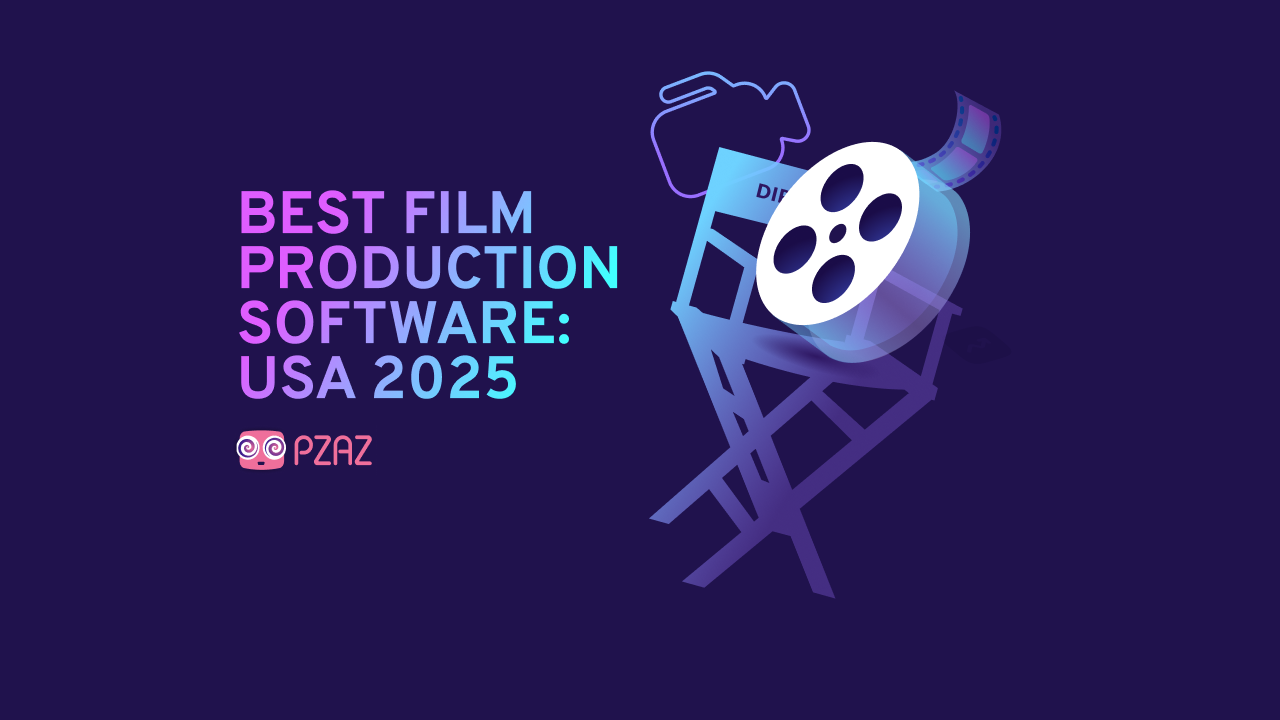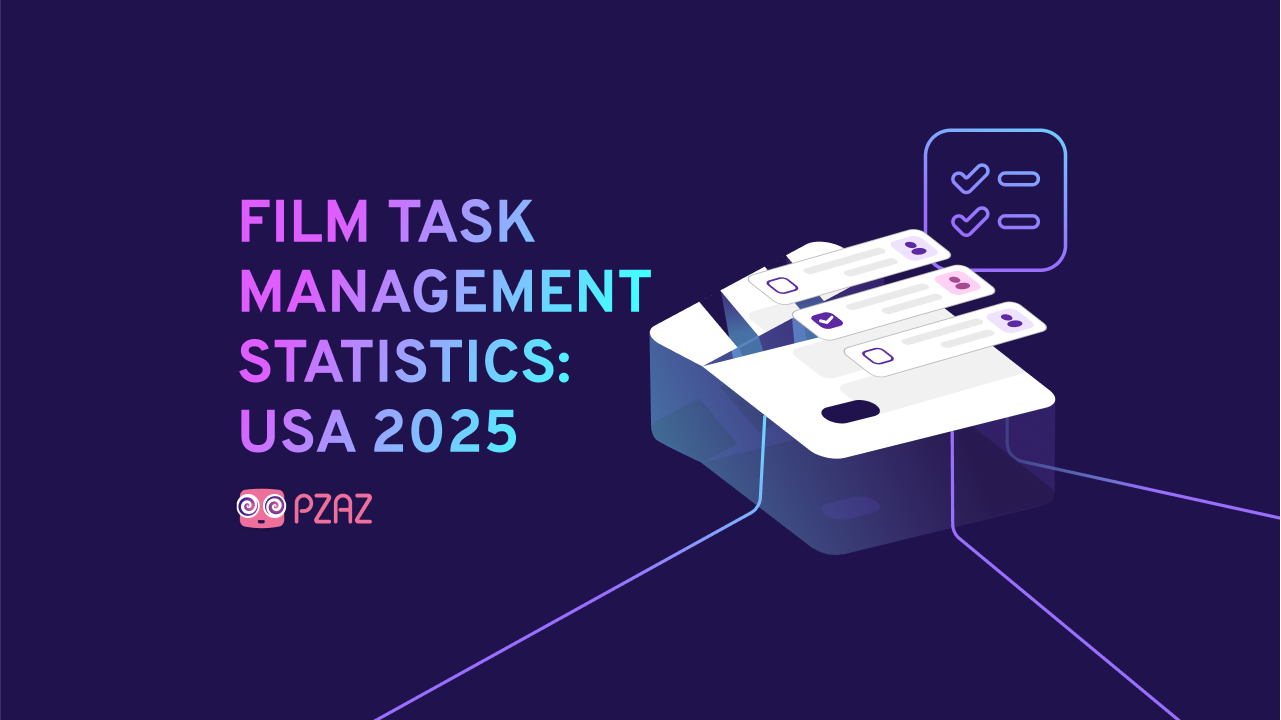
Screenwriting is about bringing bold ideas to life. To do so effectively, independent filmmakers need software that fuels creativity, adapts to their workflow, and makes collaboration seamless.
To find out what 6,260,767 independent filmmaker opinions in the US thought about screenwriting software, we used AI-driven audience profiling to synthesize insights from online discussions over a year ending 07 July 2025, to a high statistical confidence level. This gave us clear insight into what filmmakers are looking for in screenwriting software, the challenges they currently face, and what the future looks like.
Index
-
- Final Draft and Fade In are the go-to film screenwriting software tools for 28% of independent filmmakers
- Lower cost definitely inspires 27% of independent filmmakers to switch to new screenwriting software
- 22% of independent filmmakers absolutely prefer a web-based platform for screenwriting
- 21% of independent filmmakers agree that cloud-based storage is an absolutely essential screenwriting software feature
- Fountain format is an absolutely essential screenwriting software export option for 59% of independent filmmakers
- 32% of independent filmmakers find the lack of support resources somewhat frustrating in their current screenwriting software
- Commenting and feedback absolutely essential for collaboration for 76% of independent filmmakers using screenwriting software
- 21% of independent filmmakers agree that a drag and drop structure is essential for keeping their keep their workflow organized
- For 24% of independent filmmakers, character prompt suggestions are absolutely essential for film script formatting support
- 25% of independent filmmakers absolutely prefer their screenwriting software to have a bold and creative aesthetic
- Brainstorming ideas is an absolutely crucial part of the screenwriting process for 33% of independent filmmakers
- 75% of independent filmmakers primarily discover new screenwriting software on screenwriting forums
- 28% of independent filmmakers want integrated AI solutions added to their current screenwriting software
- One-on-one demos are an absolutely essential form of screenwriting software training or support for 23% of independent filmmakers
- 32% of independent filmmakers in our audience are likely located in California
- Methodology
What Film Screenwriting Software Have You Used?
Final Draft and Fade In are the go-to film screenwriting software tools for 28% of independent filmmakers
Two film screenwriting software programs emerge as the most-used:
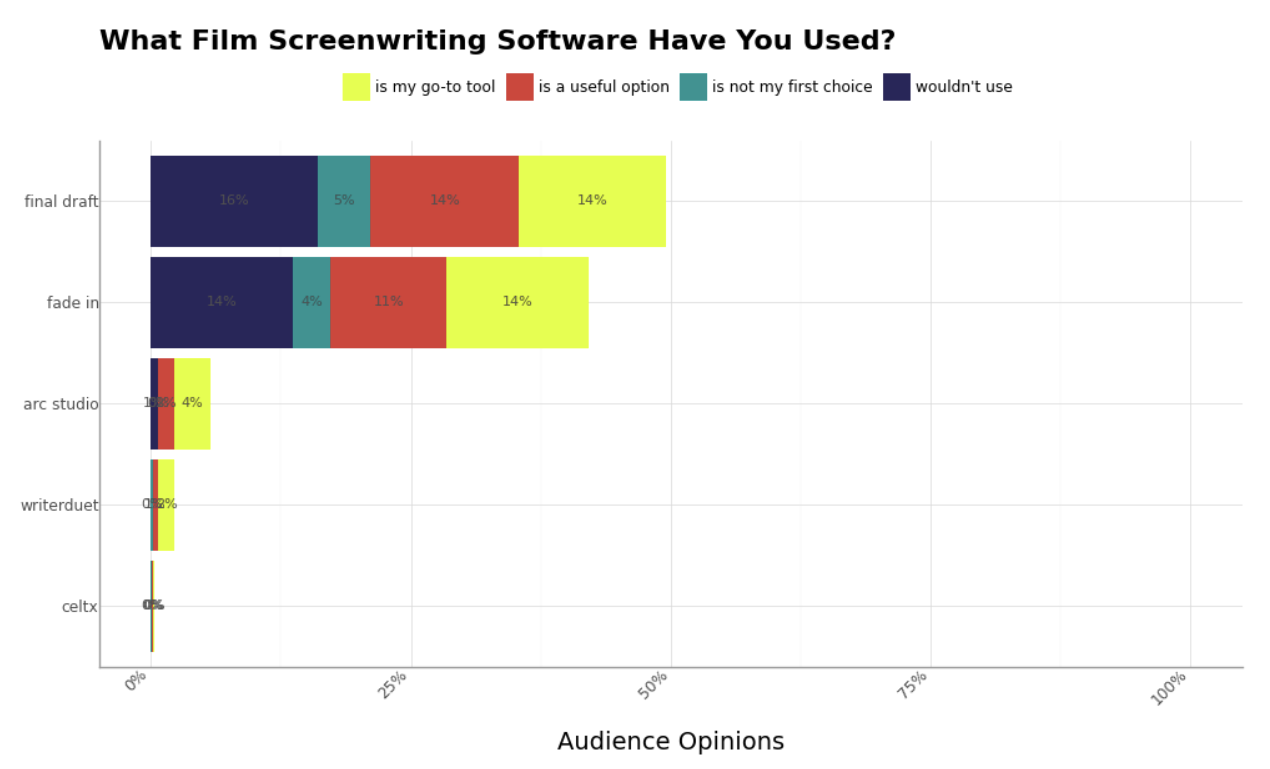
It’s estimated that the screenwriting software market is worth $500 million in 2025, and this will increase to $1.8 billion by 2033. With such a massive market, it’s interesting to note that for our audience of over six million independent filmmakers, there are just two film screenwriting software programs that stand out as the most used. Both Final Draft and Fade In are the go-to tools for 14%, while another 14% say Final Draft is a useful option, followed by 11% who feel the same about Fade In.
However, the numbers are also similar for those who say these platforms are not their first choice (5% for Final Draft and 4% for Fade In) and those who say they wouldn’t use them (16% for Final Draft and 14% for Fade In).
While no one was using Celtx, 4% said Arc was their go-to tool, and another 2% said WriterDuet was theirs. 1% also said that these two programs were a useful option, still putting them far behind Fade In and Final Draft.
What Inspires You To Switch To A New Film Screenwriting Software?
Lower cost definitely inspires 27% of independent filmmakers to switch to new screenwriting software
Some factors are more inspiring than others when switching screenwriting software:
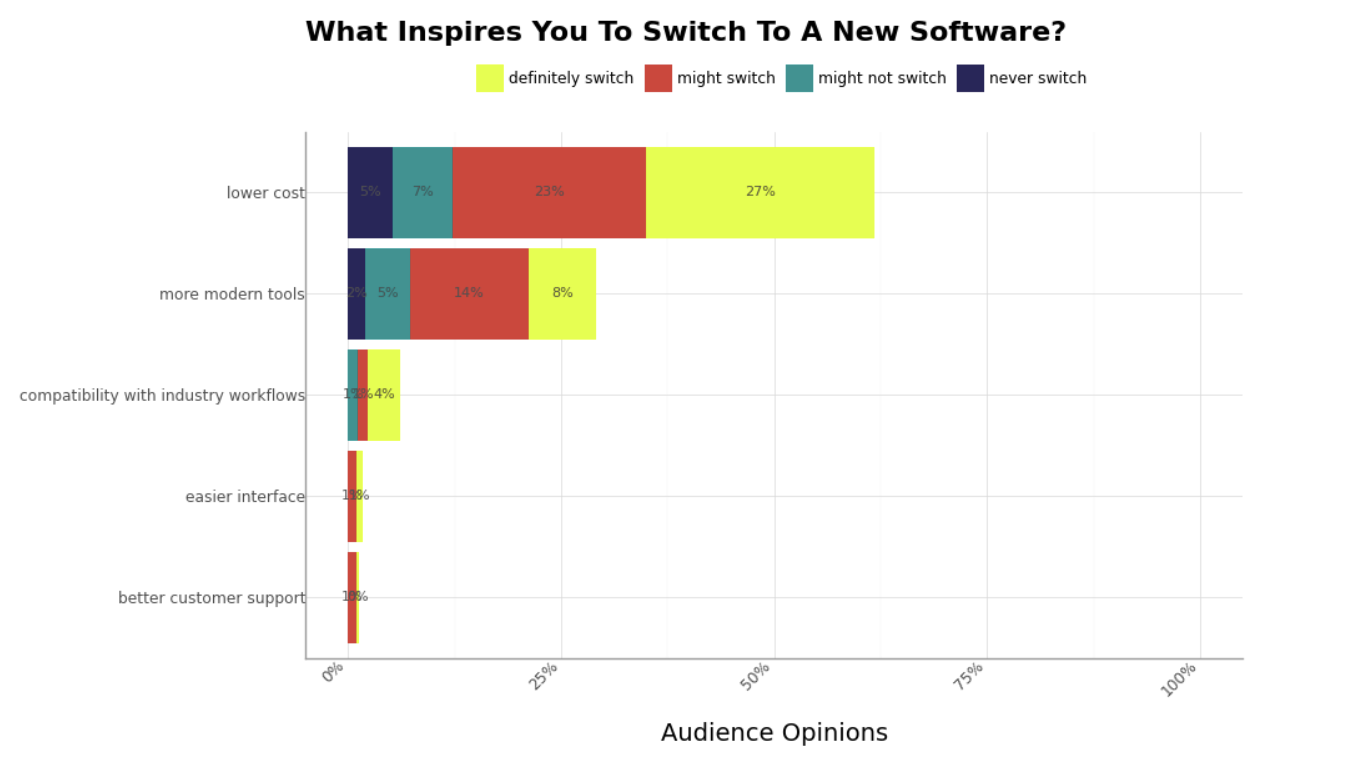
The average annual salary for screenwriters in the US is around $62,185, which is below the average US salary of $66,622. It’s understandable, then, that lower cost is the main motivator for switching to new screenwriting software. 27% of independent filmmakers would definitely switch for this reason, and 23% might do so. In contrast, 7% might not, and only 5% would never switch for a lower cost option.
More modern tools are also a reasonable incentive, with 8% definitely switching and 14% who might switch compared to 5% who might not, and 2% who would never be inspired by the inclusion of these tools.
Compatibility with industry workflows, an easier interface, and better customer support are all low down on the list, with just 4% who would definitely switch for better compatibility with workflows, 1% who might switch, and 1% who might not. Only 1% each might swap for the latter two reasons, highlighting just how important pricing is over functionality or support.
Which Film Screenwriting Environment Do You Prefer?
22% of independent filmmakers absolutely prefer a web-based platform for screenwriting
Clear preferences emerge regarding preferred writing environments:
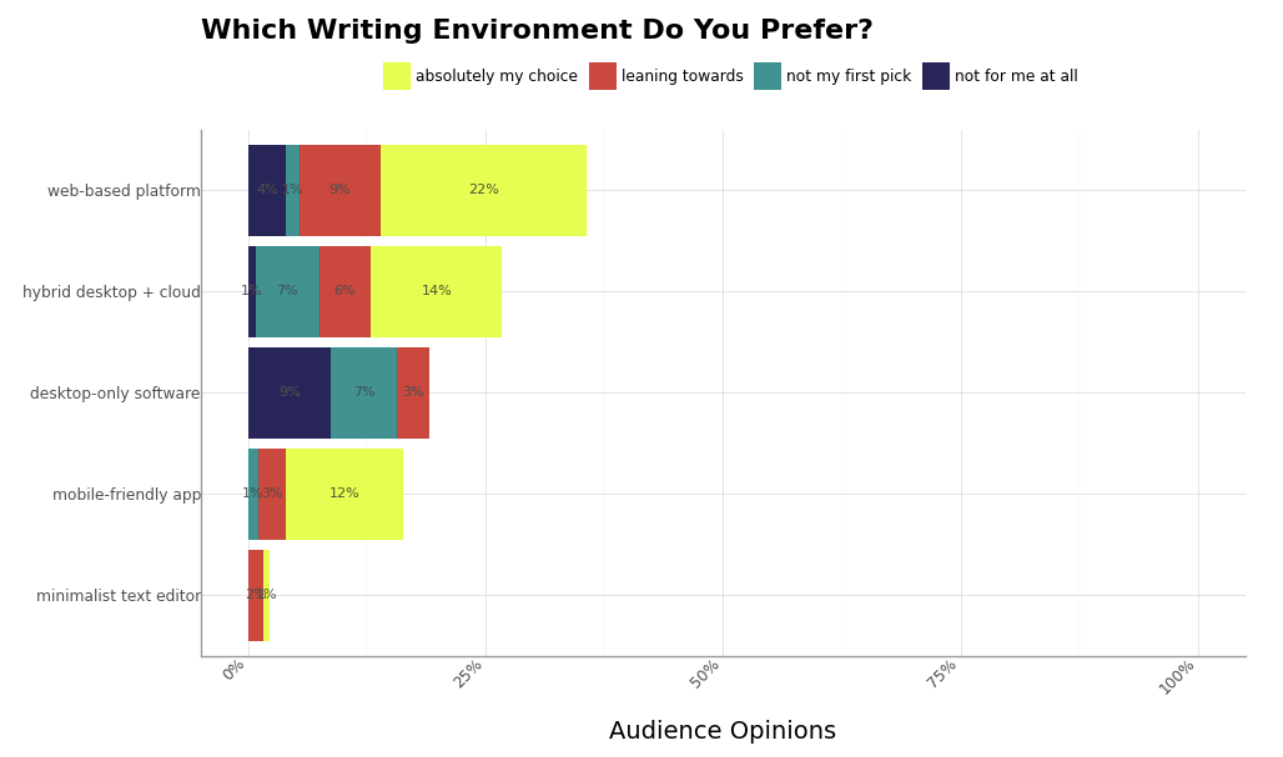
Web-based platforms lead the way as the preferred writing environment for independent filmmakers, with 22% saying it’s absolutely their choice and 9% saying they lean towards this option. Only 4% said it wasn’t for them at all, and for 1%, it wasn’t their first pick.
However, independent filmmakers were not fans of being limited to desktop-only software, with only 3% leaning towards it, 7% saying it wasn’t their first pick, and 9% agreeing it wasn’t for them at all. Conversely, hybrid desktop and cloud access had far more positive results, with 14% saying it was absolutely their choice as a writing environment and 6% leaning towards it. Yet, 7% did say it wasn’t their first pick, and 1% said it wasn’t for them, showing some discrepancy.
Interestingly, despite around 98% of the world using smartphones to access the internet versus 58% using laptops or desktop computers, only 12% said that a mobile-friendly app was their absolute first choice, 3% learnt towards this option, and 1% said it wasn’t their first pick.
The least preferred writing environment was a text editor, with just 2% leaning towards this option. As this is the most simplistic environment, and it has the biggest risk of loss due to not saving in real time, it’s understandably not a favorite.
What Feature Do You Value Most In Film Screenwriting Software?
21% of independent filmmakers agree that cloud-based storage is an absolutely essential screenwriting software feature
Cloud-based storage is the most desirable feature in screenwriting software by far:

Easily accessible from anywhere, saving in real-time, and allowing for easy collaboration, it’s easy to see why 21% of independent filmmakers say that cloud-based storage is the most valued feature in a screenwriting tool, followed by 36% who say it’s very useful. While this makes up 57% of the audience, there are still 27% who say this feature is not a priority and 10% who say it’s unnecessary, creating quite a big divide.
Other features barely got mentioned, with only 3% saying that script formatting automation was very useful, 2% agreeing real-time collaboration was absolutely essential, and another 2% feeling the same about revision tracking. As the latter two features are often covered by cloud-based storage, the minimal mentions do make sense.
Which Film Screenwriting Software Export Options Are Most Useful To You?
Fountain format is an absolutely essential screenwriting software export option for 59% of independent filmmakers
One export option stands out above all others for US independent filmmakers:
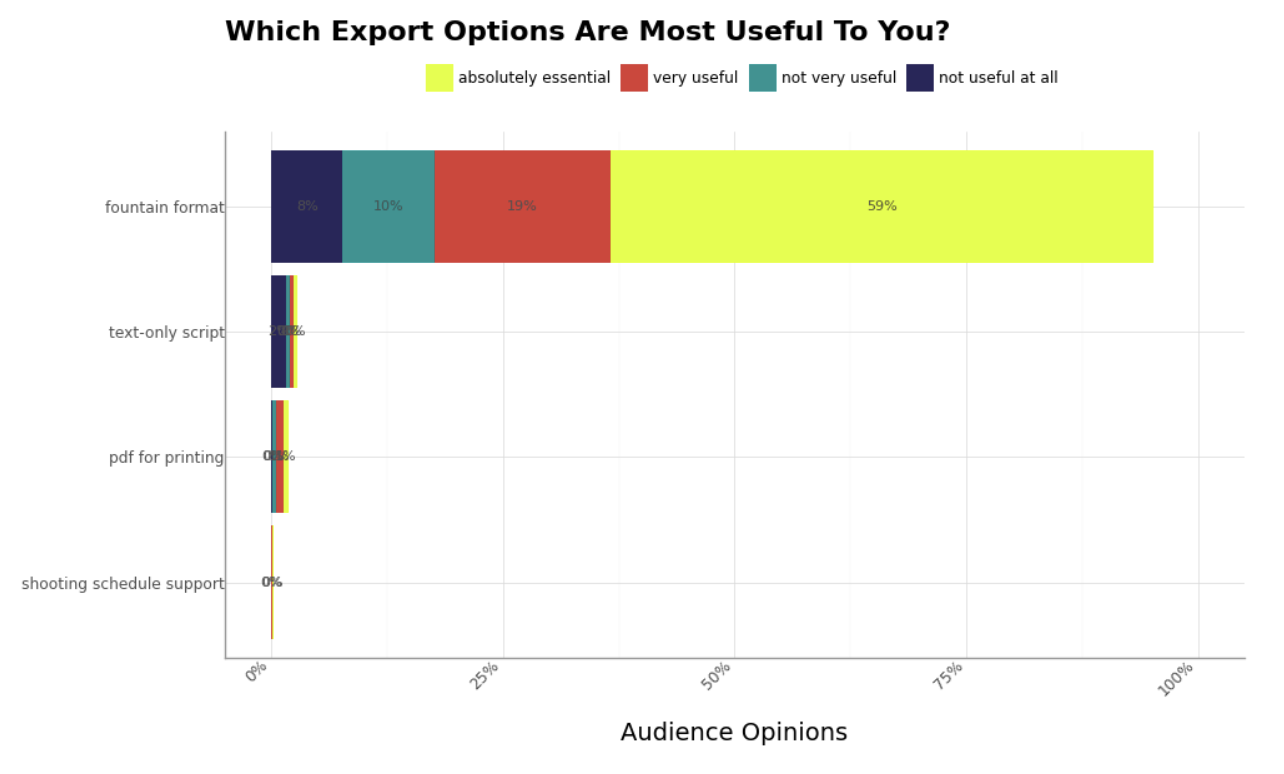
Fountain is specifically designed for screenwriting, making it possible to write a formatted screenplay in any text editor, on any device, and it’s free and open source. This explains why it’s an absolutely essential format export option for 59% of independent screenwriters. Another 19% say it’s very useful, while 10% say it’s not very useful and 8% say it’s not useful at all.
Other opinions on export options are minimal, with text-only script, PDF for printing, and scheduling support not considered useful at all. This reinforces Fountain’s status as the go-to format for flexibility, portability, and long-term access, especially among indie screenwriters who value open tools and cross-platform compatibility over traditional, locked-in software solutions.
What Frustrates You Most About Your Current Film Screenwriting Software?
32% of independent filmmakers find the lack of support resources somewhat frustrating in their current screenwriting software
Many screenwriting tools have a major pain point in common:
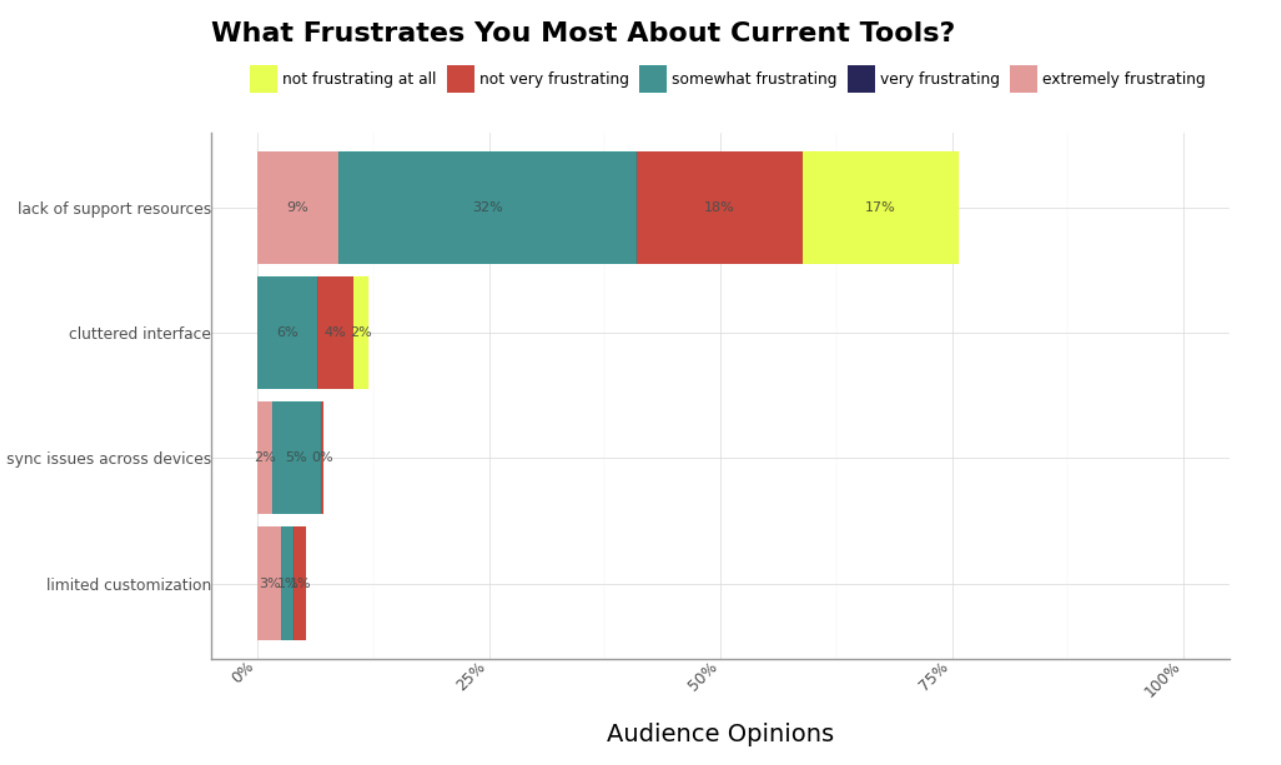
The screenwriting software that independent filmmakers are currently using seems to lack support resources to some degree, with 32% finding this somewhat frustrating and 9% saying it’s extremely so. Conversely, 18% said this lack of support wasn’t very frustrating, and 17% said it was not frustrating at all.
Other pain points were a cluttered interface, which was somewhat frustrating for 6%, while not very frustrating for 4% and not frustrating at all for 2%, followed by sync issues across devices which was somewhat frustrating for 5% and extremely frustrating for 2%, and 3% who found limited customization to be extremely frustrating and another 1% who said this was somewhat so. This suggests that independent filmmakers are more tolerant of design and functionality flaws in screenwriting software than they are of poor support.
What Kind Of Collaboration Do You Need Most In Film Screenwriting Software?
Commenting and feedback absolutely essential for collaboration for 76% of independent filmmakers using screenwriting software
Independent filmmakers’ collaboration needs are clear:
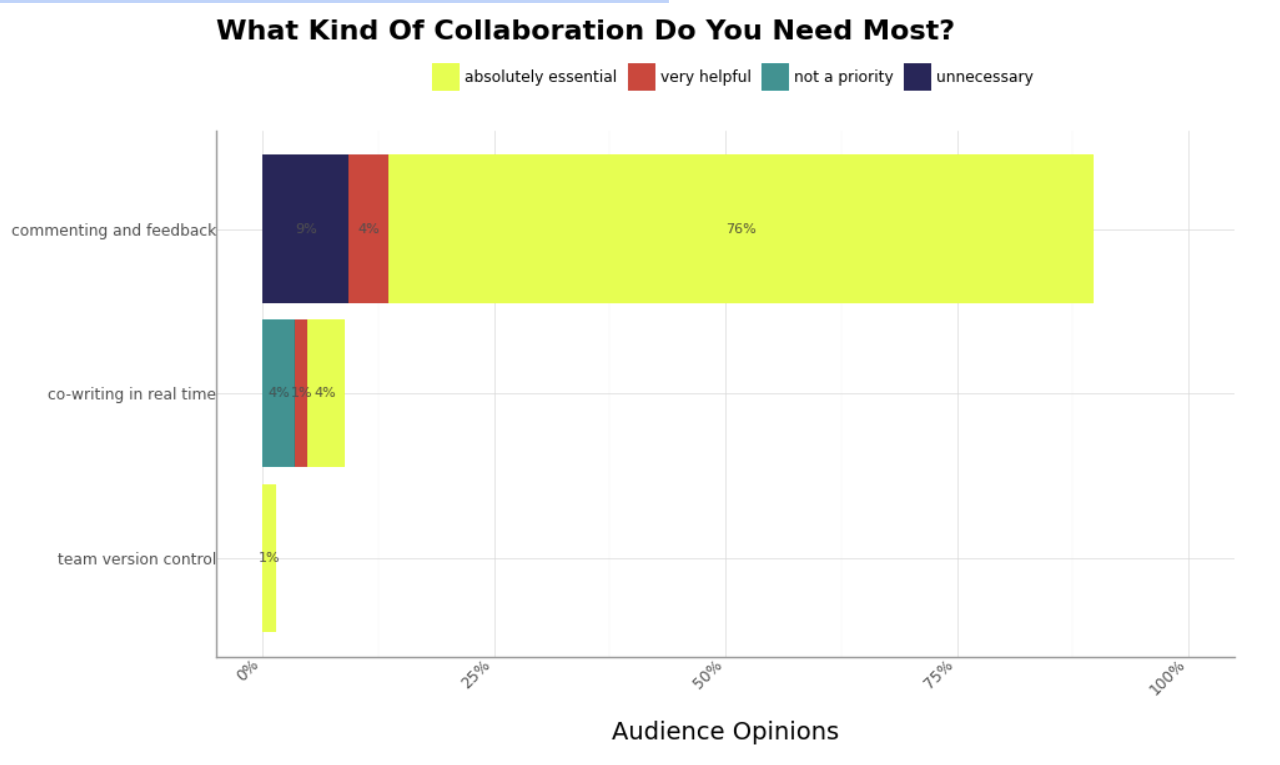
Although almost 66% of movies credit one person as the main screenwriter, there are often a number of people who collaborate on the script or the film as a whole. For our audience, this is clearly important, as 76% agree that they need commenting and feedback functionality in their screenwriting software to facilitate collaboration. 4% also find this very helpful, while 9% feel the opposite, saying it’s unnecessary.
1% find team version control absolutely necessary, and 4% share the same sentiments about co-writing in real time, with another 1% saying this is very helpful and 4% saying it’s not a priority. It’s obvious where priorities lie, then, and the type of collaboration that’s most in demand.
What Helps Keep Your Screenwriting Workflow Organized?
21% of independent filmmakers agree that a drag and drop structure is essential for keeping their keep their workflow organized
An organized workflow is essential, with screenwriters having different priorities to stay on track:
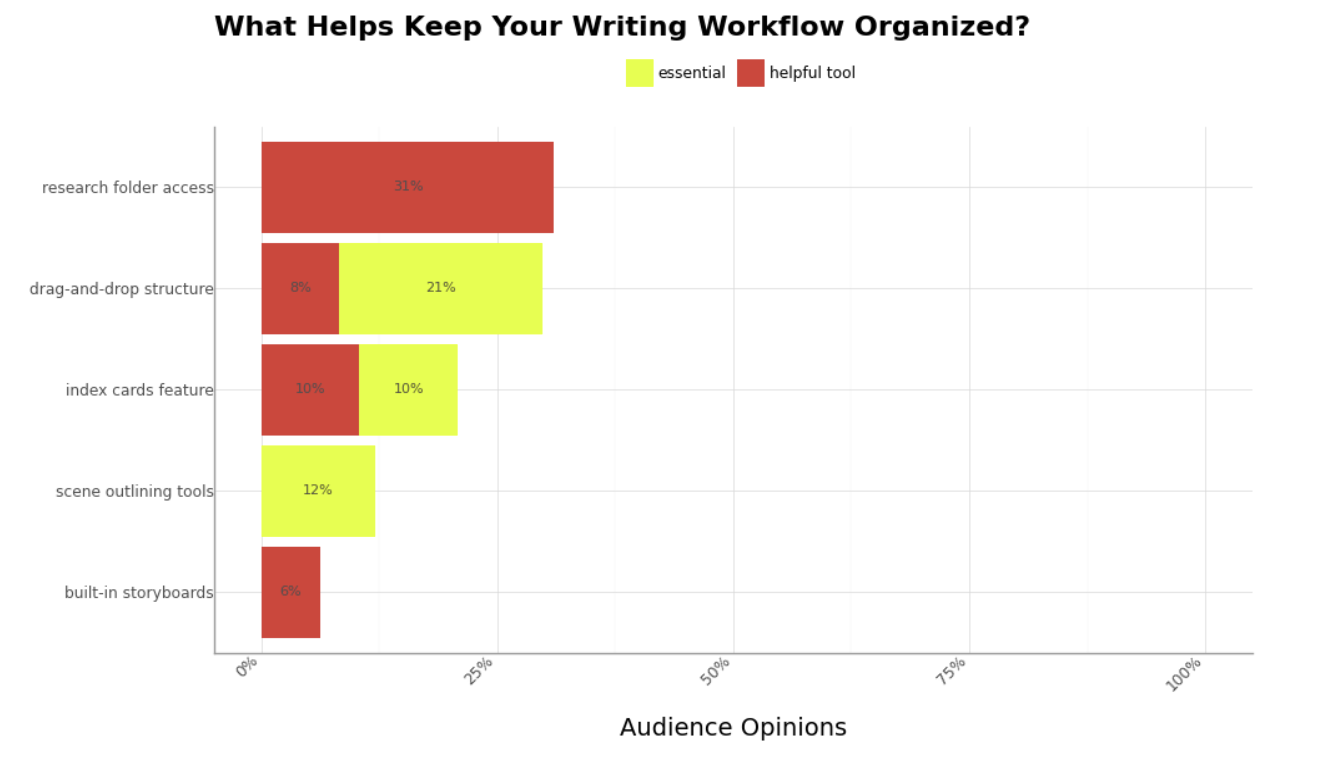
For our audience of independent filmmakers in the US, there are a few key ways that screenwriting software keeps their writing workflow organized. The most popular is a drag-and-drop structure that allows files to be moved easily between folders, with 21% saying this is essential and 8% saying it’s a helpful tool.
Scene outlining tools were considered essential for 12%, and 10% felt the same about an index card feature, with another 10% saying this was a helpful tool. Just under a third of the audience (31%) said that research folder access was a helpful tool, while another 6% said the same about built-in storyboards. While these all scored lower than drag-and-drop functionality, it’s clear they contribute somewhat to the overall process of staying organized.
What Kind Of Film Script Formatting Support Do You Rely On Most?
For 24% of independent filmmakers, character prompt suggestions are absolutely essential for film script formatting support
Preferences for the type of script formatting support differ:
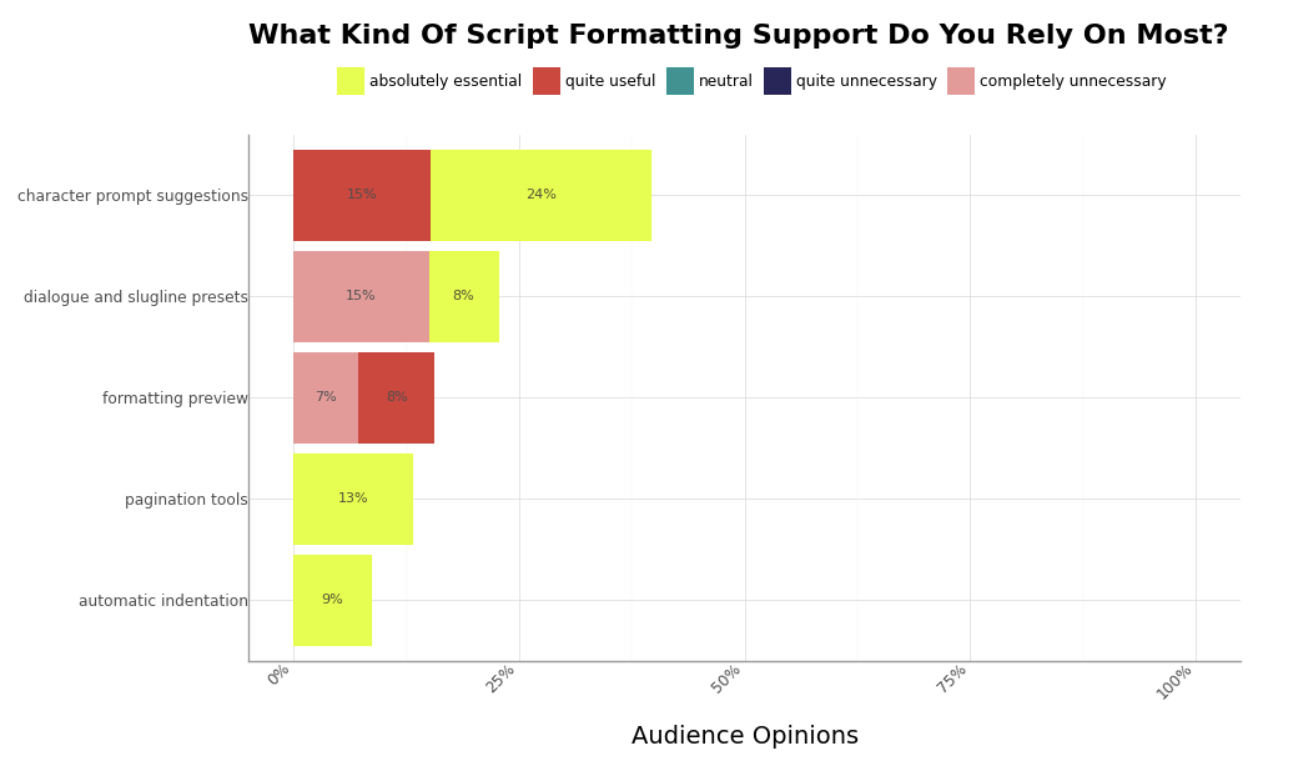
Even the most experienced screenwriter will agree that character development is often challenging. So, it’s understandable that 24% of our audience of independent filmmakers think that character prompt suggestions are absolutely essential, and 15% say they’re quite useful.
Next on the list of the type of script formatting support that’s relied on the most are those who feel pagination tools (13%) and automatic indentation (9%) are absolutely essential. 8% also feel this way about dialogue and slugline presets, but 15% say they’re completely unnecessary.
Last on the list is formatting previews, with 8% saying they’re quite useful and 7% saying they’re completely unnecessary, proving that there’s very little demand for this type of formatting.
Which Aesthetic Do You Prefer In Film Screenwriting Software?
25% of independent filmmakers absolutely prefer their screenwriting software to have a bold and creative aesthetic
There are some clear trends in the preferences for the way a screenwriting platform looks:
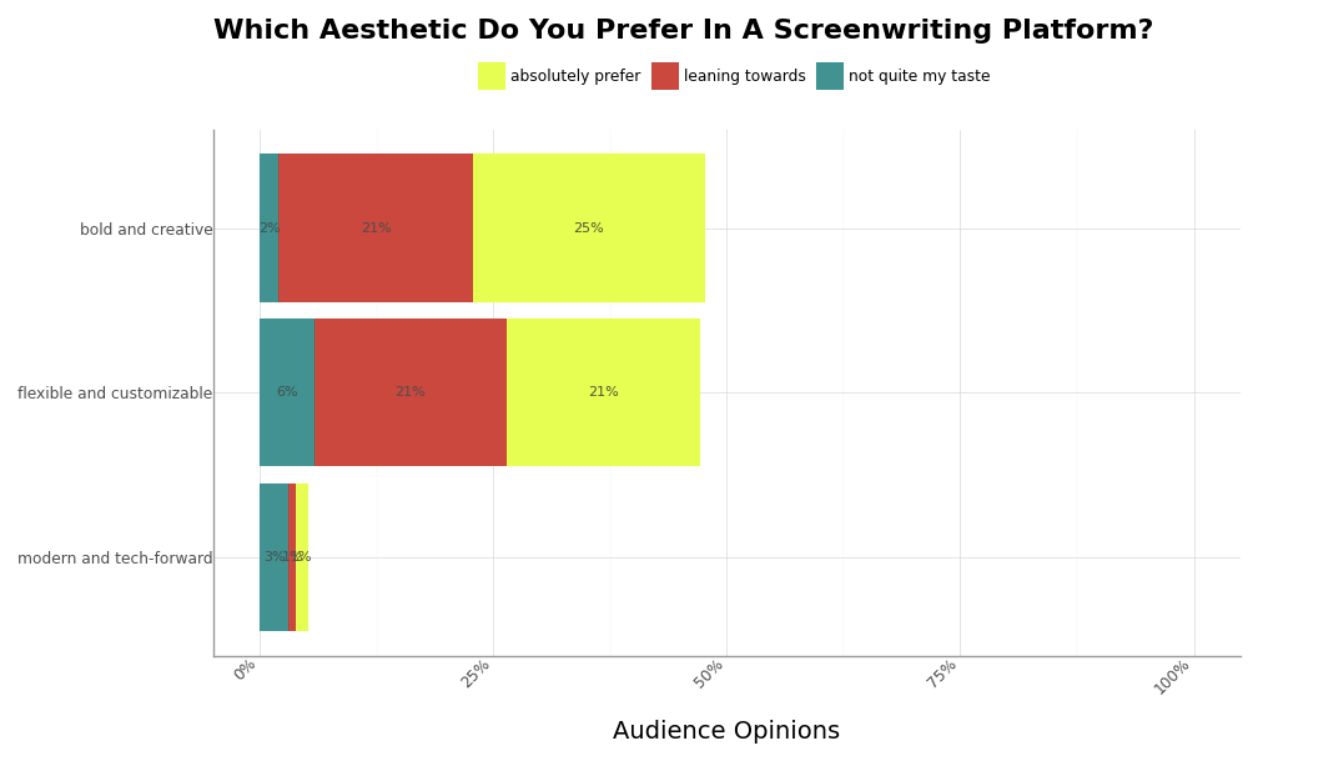
Screenwriting is a bold and creative pursuit, and our audience agrees that the aesthetic of a screenwriting platform should match. 25% absolutely prefer this look and 21% lean towards it, with just 2% saying it’s not quite their taste.
Flexibility and customization are a close second as they enhance the user experience, with 21% absolutely preferring this aesthetic and the same number leaning towards it. However, a few filmmakers (6%) say this isn’t quite their taste, and 3% feel the same way about an aesthetic that’s modern and tech-forward.
A meagre 1% absolutely prefer the latter aesthetic, which suggests that independent filmmakers value creativity and personalization over a sleek, corporate feel when choosing their screenwriting tools.
Which Part Of The Screenwriting Process Is Most Important To Streamline?
Brainstorming ideas is an absolutely crucial part of the screenwriting process for 33% of independent filmmakers
Two parts of the screenwriting process stand out as needing refinement:

Every script starts with an idea, and for our audience, this is the part of the screenwriting process that’s the most important to streamline. 33% say that brainstorming ideas is absolutely crucial, 12% say it’s quite important, and 4% somewhat important. 5% say it’s not important at all, and 4% feel the same way about writing the first draft. However, 12% feel that streamlining the writing of the first draft is quite important, 9% that it’s absolutely crucial, and 8% somewhat important.
Creating outlines also needs some streamlining, with 10% of independent filmmakers saying it’s absolutely crucial that this process is refined, and 4% agreeing it’s quite important. No one thought that preparing final scripts was an important part of the process to streamline, highlighting the fact that by this stage, most of the important elements are fully in place if they’re organized properly.
How Do You Typically Discover New Film Screenwriting Software?
75% of independent filmmakers primarily discover new screenwriting software on screenwriting forums
Screenwriting forums are evidently a wealth of information for making discoveries:
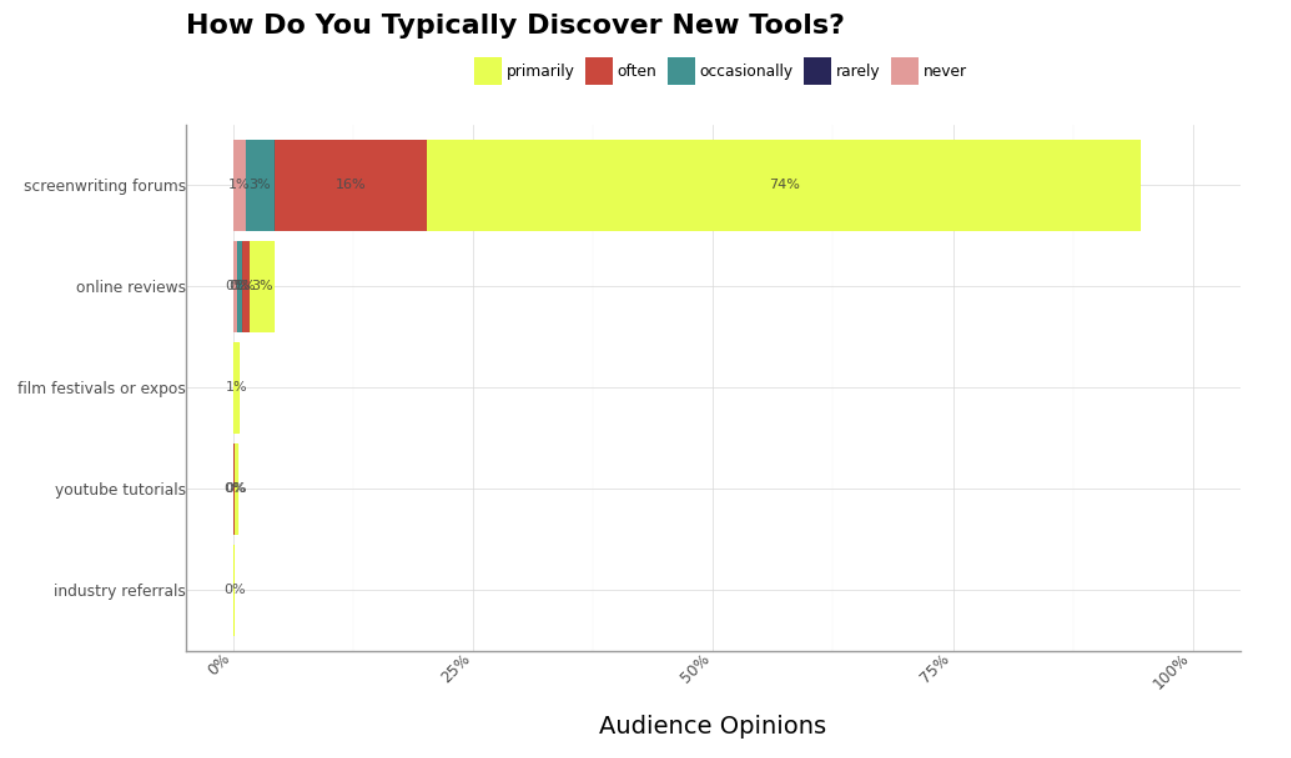
Reddit has a community of over 1.7 million screenwriters, and this is just the tip of the iceberg. There are plenty of other forums too, so it’s easy to see why they’re such a valuable source of information for those in the industry. Our audience agrees, with 74% of them saying that they primarily discover new filmmaking tools and screenwriting software from their peers on these platforms. 16% say they make new discoveries often, and 3% do so occasionally, with just 1% saying they never do so.
Online reviews are primarily responsible for 3% discovering new tools, and film festivals and expos for 1%. Interestingly, YouTube tutorials and industry referrals are not mentioned at all, despite also being popular ways of sharing information.
What Feature Would You Most Like To See Added To Your Current Film Screenwriting Software?
28% of independent filmmakers want integrated AI solutions added to their current screenwriting software
With the rise of AI, more independent filmmakers want this technology in their software:
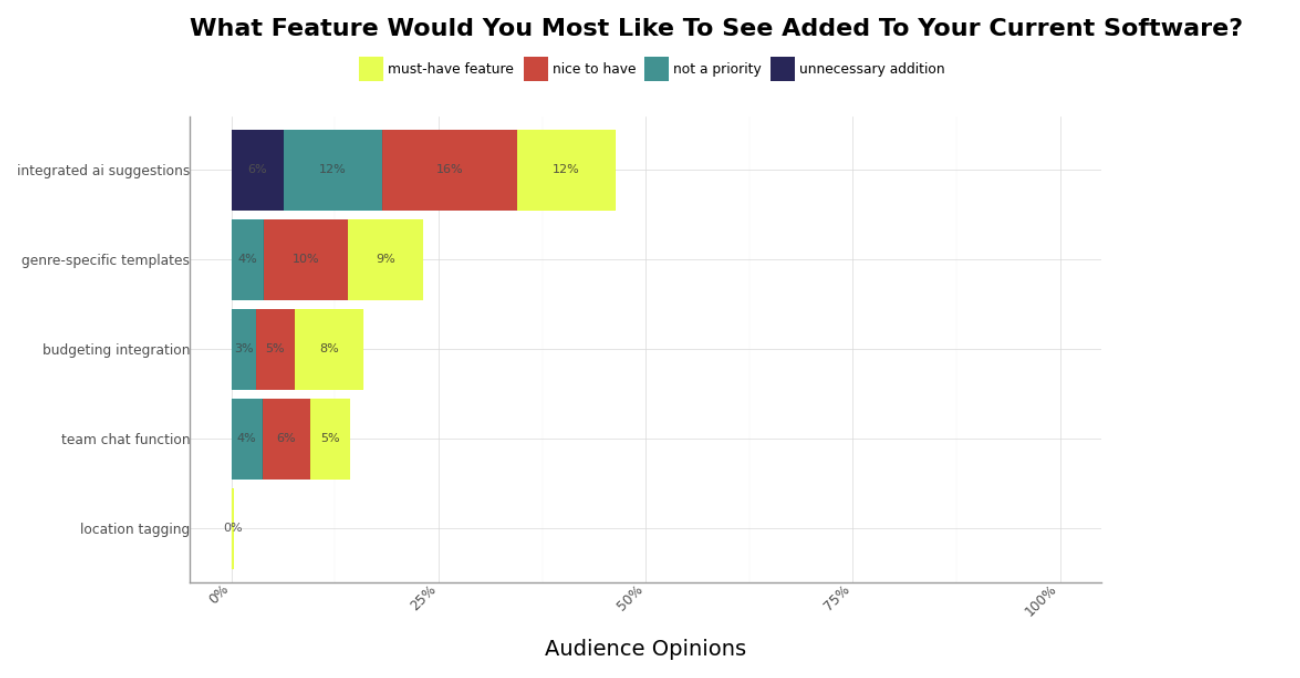
With the rise of AI and the global AI film market set to be worth $14.1 billion by 2033, this technology is in huge demand. It’s also the feature that the largest portion of our audience wants to see added to their current software, with 12% saying that integrated AI suggestions are a must-have feature and 16% saying they’re nice to have. Yet, 12% say they are not a priority, and 6% that they’re an unnecessary addition, highlighting possible concerns about copyright and ethics.
Genre-specific templates are a must-have feature for 9%, 8% feel this way about budgeting integration, and 5% about the team chat function. Genre-specific templates are also nice-to-have for 19% and 4% say they’re not a priority, and for budgeting integration, 5% and 3% share the same opinion.
For the team chat function, 6% agree it’s nice to have, while 4% say it’s not a priority, making it the least desired add-on, second only to location tagging, which no one expressed an opinion about.
What Film Screenwriting Software Training Or Support Do You Find Most Useful?
One-on-one demos are an absolutely essential form of screenwriting software training or support for 23% of independent filmmakers
Preferences for training or support types indicate specific trends:
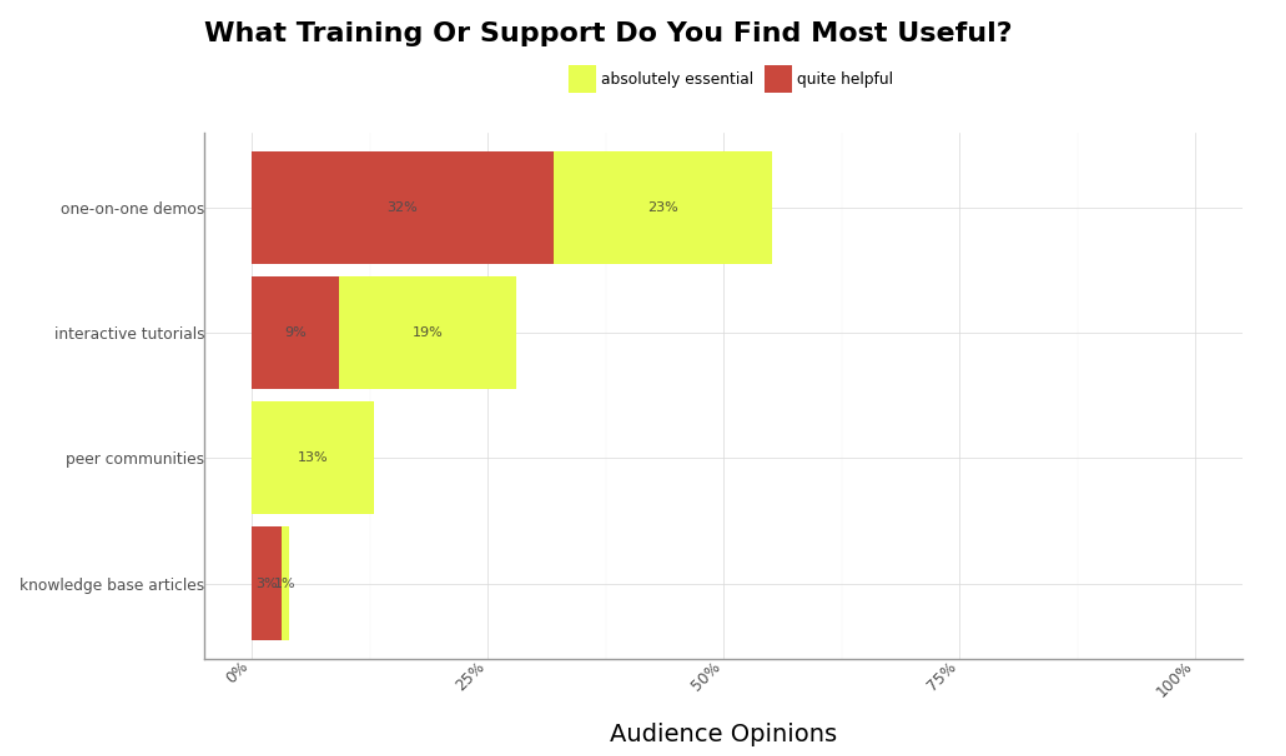
With over 50% of our audience of independent filmmakers saying they prefer (23% absolutely essential and 32% quite helpful) one-on-one demos when learning how to use their screenwriting software, it’s obvious this is the preferred method of support, and it’s an excellent opportunity to build trust and confidence from the start.
Interactive tutorials are popular too, with 19% saying they are absolutely essential and 9% finding them quite helpful. Peer communities are absolutely essential for 13% while 1% share this opinion of knowledge base articles, and 3% find them quite helpful. As 65% of people are visual learners, the preferences for demos and interactive tutorials make sense.
Which Region Best Describes Your Current Location?
32% of independent filmmakers in our audience are likely located in California
California may lead the way, but there’s a second US location that’s home to a number of independent filmmakers: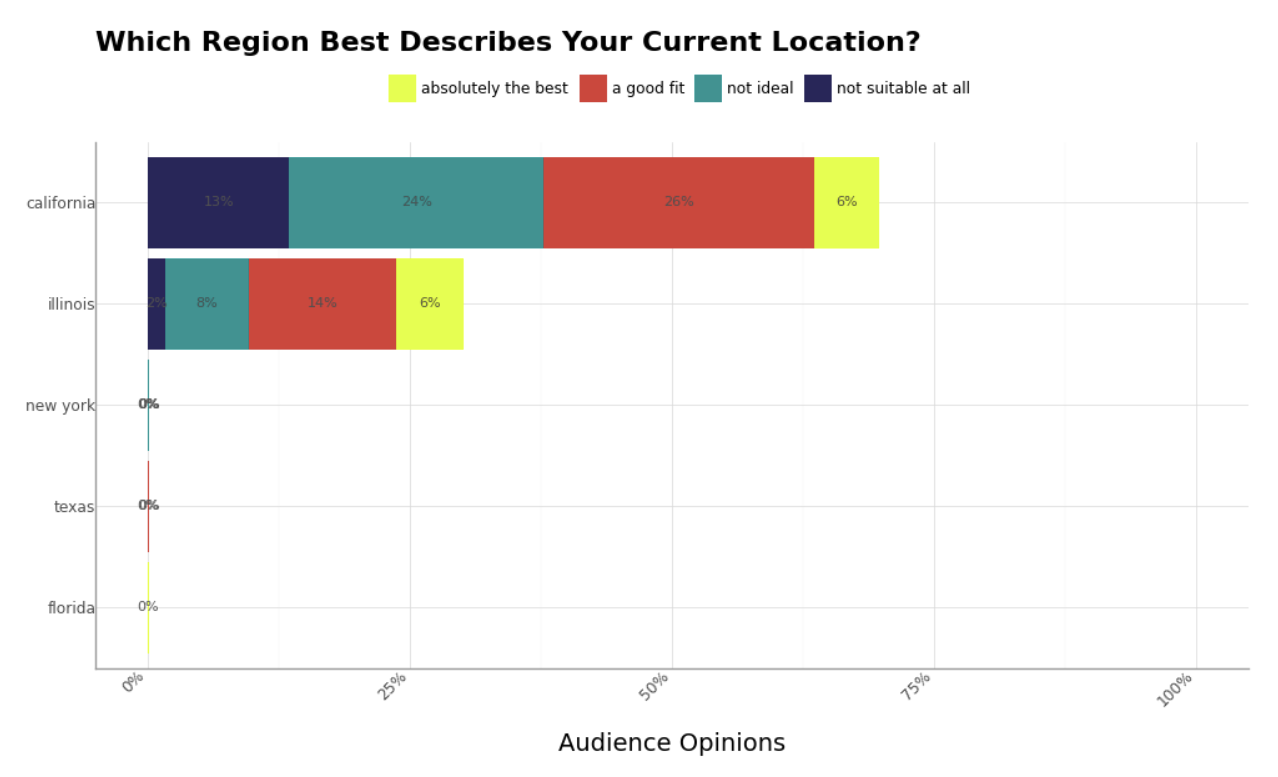
With Hollywood being the epicenter of the film industry, California is an obvious location choice for independent filmmakers. 6% of our audience says this region is absolutely the best description of where they’re based, and 26% say it’s a good fit. However, 24% say it’s not ideal, and 13% agree it’s not suitable at all. This may be due to the high costs associated with living in this state.
Yet, the same number (6%) says Illinois is absolutely the best fit for their location. But, when you consider that Illinois has been breaking film industry records with its expenditure, maybe it’s not too surprising that so many independent filmmakers are based here. 14% also say it’s a good fit, while just 8% say it is not ideal, and 2% not suitable at all. In contrast, New York, Texas, and Florida did not get any mention, putting California and Illinois almost on par in popularity.
This comprehensive snapshot of independent filmmakers in the US reveals a screenwriting software market driven by creativity, collaboration, and cost-consciousness. The findings also show how the screenwriters’ needs are evolving, and platforms that are intuitive, utilize AI, and are built for the collaborative nature of filmmaking are in high demand.
Methodology
Sourced using Artios from an independent sample of 6,260,767 United States independent filmmakers’ opinions across X, Reddit, TikTok, LinkedIn, Threads, and BlueSky. Responses are collected within a 95% confidence interval and 5% margin of error. Results are derived from opinions expressed online, not actual questions answered by people in the sample.
About the representative sample:
- 52% of independent filmmakers in the US are between the ages of 35 and 64.
- 54% identify as male and 46% as female.
- 38% earn between $120,000 and $200,000 annually, putting them above the industry average.
Best Film Production Software: USA 2025
Find out what filmmakers value most in their software tools, from editing support to progress tracking and post-production help, and learn why Pzaz is the ultimate creative partner in bringing your stories to life.
Film Task Management Statistics: USA 2025
Discover key film task management statistics from 1,063 independent US filmmakers in 2025. Learn how they handle deadlines, tools, team updates, and task dependencies to keep productions on track.

